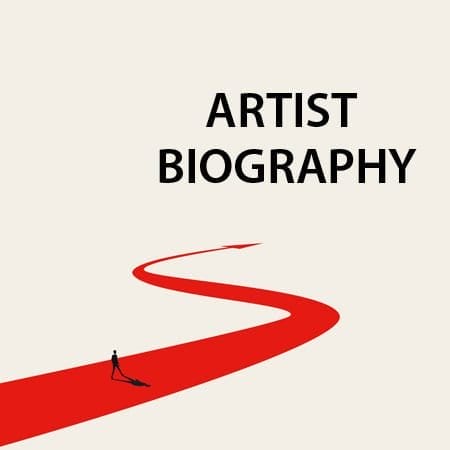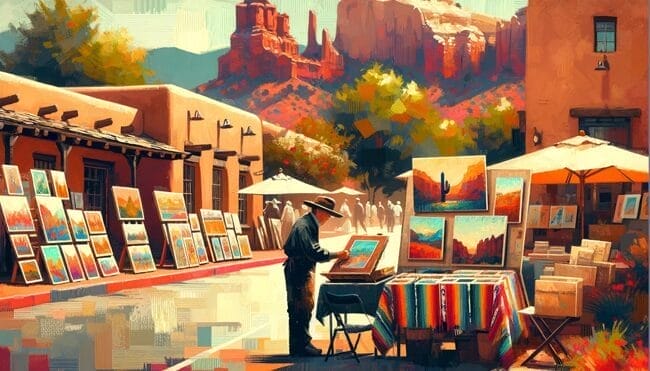Artists often overlook the importance of a well-written bio and “About Me” page. However, a compelling artist’s biography is a vital part of your professional toolkit that can help establish your credibility, connect with your audience, and showcase your unique story.

In this article, we will delve into the purpose of an artist’s bio, essential components to include, tips for writing an engaging bio, an example of a successful artist’s bios, common mistakes to avoid, and how to use your bio effectively.
By the end of this article, you will have a clear understanding of the significance of an artist’s bio and how to create one that leaves a lasting impression on your audience.
Understanding the Purpose of an Artist’s Bio
An artist’s bio serves several important purposes that can contribute to your success as an artist. Let’s discuss these key aspects to better understand why a well-crafted bio is essential:
Artist’s Bio Example
Jane Smith is a contemporary painter based in New York City, known for her expressive abstract compositions and bold use of color. Born and raised in the bustling metropolis, Jane discovered a passion for art early in life, inspired by the vibrant energy and diversity of her surroundings.
Jane pursued her artistic education at the prestigious Rhode Island School of Design (RISD) and further honed her skills through various workshops and residencies. Her work has been showcased in numerous solo and group exhibitions at renowned galleries, such as the Brooklyn Art Space, the Chelsea Art Gallery, and the Museum of Contemporary Art. Jane’s talent has garnered recognition, including the prestigious National Endowment for the Arts Fellowship and the Pollock-Krasner Foundation Grant.
Influenced by abstract expressionists like Jackson Pollock and Helen Frankenthaler, Jane seeks to capture the essence of emotion and the human experience in her work. She employs a unique technique of layering and dripping paint, resulting in mesmerizing, textured compositions that evoke a sense of movement and depth.
When not in her studio, Jane enjoys exploring the hidden gems of New York City, attending live music performances, and practicing yoga. She is committed to her artistic growth and looks forward to experimenting with new mediums, collaborating with other artists, and sharing her work with a wider audience.
Stay updated on Jane Smith’s latest works and exhibitions by visiting her website at www.janesmithart.com or following her on Instagram @janesmithart and Twitter @JaneSmithArtNYC.
READ MORE: Mastering Your Artist Narrative

Essential Components of an Effective Artist’s Bio
The key components that make a bio both informative and engaging are:
Personal background
Start by introducing yourself and providing some context about your background. This can include your upbringing, your artistic journey, and any life experiences that have shaped your work. For instance, if you’re a landscape painter, you might discuss how growing up in a rural area sparked your love for nature and influenced your artistic style.
Education and training
Share your educational background, any formal art training, and significant workshops or courses you’ve attended. This information helps establish your credibility as an artist and demonstrates your commitment to your craft.
Exhibitions and achievements
Highlight your most notable exhibitions, awards, and accomplishments. Focus on those that are most relevant to your current work or artistic direction. This can include solo shows, group exhibitions, or notable collections where your work is featured.
Artistic influences and inspirations
Discuss the artists, movements, or experiences that have inspired or influenced your work. This can help your audience understand the context behind your art and connect more deeply with your creative vision.
Unique techniques or styles
Describe any unique techniques, materials, or styles that define your work. This can help set you apart from other artists and showcase your individuality.

Common Mistakes to Avoid
Creating a compelling artist’s bio requires careful consideration. Here are some common mistakes to avoid when crafting your bio:
Use Your Artist’s Bio Effectively
Once you have crafted a compelling artist’s bio, it’s essential to utilize it effectively to support your artistic career. Here are some ways to make the most of your bio:
- Incorporating it into your website or portfolio – Include your bio on your website or online portfolio, allowing visitors to learn more about you and your work. This can help create a connection with potential collectors, curators, or fans who visit your site.
- Including it in exhibition materials – When participating in exhibitions, provide your bio alongside your artwork. This gives viewers context for your work and helps establish your credibility as an artist.
- Sharing it with galleries and collectors – When approaching galleries or collectors, include your bio in your submission materials. A well-crafted bio can help demonstrate your professionalism and increase your chances of being considered for representation or acquisition.
- Utilizing it for marketing and promotion – Use your bio in marketing materials, such as press releases, social media profiles, or artist statements. This helps build your brand and publicize your accomplishments, increasing awareness and interest in your work.
Artist Bio Template
[Your Full Name] is a [type of artist, e.g., painter, sculptor, photographer] based in [your city or region], renowned for [a brief description of your artistic style, e.g., captivating abstract landscapes or evocative black-and-white portraits]. Born in [your birthplace], [Your First Name] found a love for art at a young age, inspired by [a personal experience or influence, e.g., the local art scene or a family member who was an artist].
[Your First Name] pursued their artistic education at [the name of the institution where you studied or trained] and refined their skills through [any workshops or additional courses you’ve attended]. Their work has been showcased in [list a few notable exhibitions, e.g., prestigious galleries, solo shows, or group exhibitions] and has earned recognition with awards such as [mention any significant awards or honors you’ve received].
Influenced by [list a few artists, movements, or experiences that have inspired your work], [Your First Name] aims to [briefly describe your artistic vision or message, e.g., explore the relationship between nature and human emotion or challenge societal norms through thought-provoking imagery]. [Your First Name] employs distinctive techniques such as [describe any unique techniques, materials, or styles that define your work], resulting in [a brief description of the impact or experience your art creates, e.g., an immersive visual journey or a deeply personal connection with the viewer].
Outside the studio, [Your First Name] enjoys [share a few personal hobbies or interests, e.g., hiking in the nearby mountains, volunteering at the local animal shelter, or traveling the world in search of inspiration]. [Your First Name] is dedicated to their artistic growth and looks forward to [mention your future artistic goals, e.g., exploring new mediums, collaborating with other artists, or engaging with a wider audience].
Stay updated on [Your Full Name]‘s latest works and exhibitions by visiting their website at [your website URL] or following them on [list your social media platforms with their corresponding handles or usernames].






